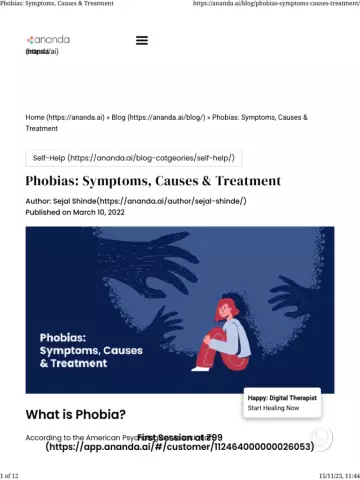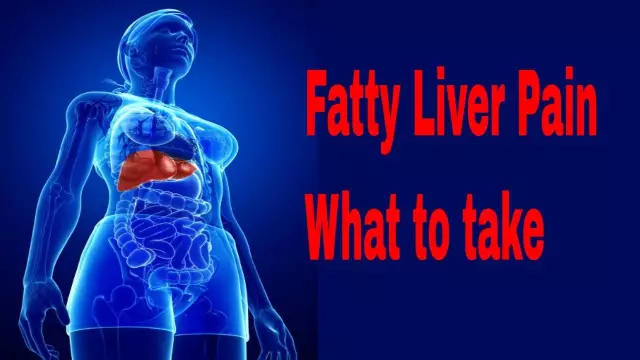- Author Rachel Wainwright [email protected].
- Public 2023-12-15 07:39.
- Last modified 2025-11-02 20:14.
Dorsalgia
The content of the article:
- Causes
- Kinds
- Signs
- Diagnostics
- Treatment
- Therapeutic gymnastics for dorsalgia
- Prevention
Dorsalgia is pain in the back. According to medical statistics, every second person of working age faces the problem of back pain from time to time. At the same time, no more than 15-20% of patients seek medical help.
The appearance of dorsalgia in about 95% of cases is associated with osteochondrosis of the spine, in which the facet vertebral joints, dorsal muscles and spinal nerve roots are drawn into the pathological process.
This, in turn, impairs the functioning of the internal organs. For example, dorsalgia of the thoracic spine is often combined with arrhythmias, respiratory disorders, and the lumbar spine - with dysfunction of the digestive system and pelvic organs.

Source: ayrspinalcare.com
Causes
There are a large number of diseases and pathological conditions, accompanied by the development of dorsalgia:
- osteochondrosis of the spine is a chronic disease, which is based on degenerative-dystrophic processes occurring in the tissue of intervertebral discs;
- excessive muscle loads - they can be both dynamic (playing sports, physical work) and static (prolonged stay in one position, for example, in a sitting position);
- compression fracture of the spine - dorsalgia caused by this reason, is observed mainly in elderly patients suffering from osteoprosis;
- herniated intervertebral discs - prolapse or protrusion of a fragment of an intervertebral disc into the spinal canal, leading to compression of nerve structures, which provokes the development of dorsalgia;
- spondylolisthesis - displacement of one vertebra relative to the body of another, resulting in a kind of "step";
- Bechterew's disease (ankylosing spondylitis) - a chronic progressive inflammation of the articular-ligamentous apparatus of the spine, one of the symptoms of which is back pain, combined with muscle tension;
- back muscle injuries - inflammation (myositis), sprain;
- obesity - excess weight significantly increases the load on the spine and back muscles, which leads to dorsalgia;
- curvature of the spine;
- shingles - damage to the intercostal nerves by the herpes virus;
- intercostal neuralgia;
- diseases of internal organs - pleurisy, hepatic and renal colic, peptic ulcer of the stomach and duodenum, pancreatitis, pyelonephritis, angina pectoris, gynecological diseases, prostatitis, colitis;
- malignant neoplasms - according to statistics, in about 0.7% of cases, the cause of dorsalgia is malignant tumors of the spine (primary or metastatic);
- Infectious lesions of the spine are the rarest cause of dorsalgia (observed in less than 0.01% of cases).
Kinds
Depending on the place of localization of pain in the back, several types of dorsalgia are distinguished:
- cervicalgia - patients complain of pain in the back of the neck and shoulders;
- thoracalgia - pain is felt in the chest area;
- lumbodynia - pains are localized in the lumbar region.

Source: myshared.ru
Signs
Back pain can take on a different nature: acute, chronic, burning, throbbing, shooting, pulling, aching, paroxysmal, etc. It can persist for a long time (months, years), or it can be short-term, occurring sporadically or regularly …
Pain arising from diseases and injuries of the spine, usually increases with the patient's movements. At the same time, dorsalgia caused by diseases of the internal organs is usually permanent and does not depend on the patient's activity.
Dorsalgia associated with lesions of the nervous structures of the spinal cord, for example, with a herniated disc, is often combined with disorders of the skin sensitivity of the extremities, muscle weakness, and disorders of the functions of the pelvic organs.
Diagnostics
Identification of the cause that led to the development of dorsalgia often presents significant diagnostic difficulties. The patient is consulted by doctors of various specialties: vertebrologist, therapist, neurologist, gynecologist, urologist, gastroenterologist, pulmonologist, cardiologist. Depending on the symptoms identified during the medical examination, a laboratory and instrumental examination is prescribed, which includes:
- radiography (spine, chest organs, organs of the gastrointestinal tract with contrast, excretory urography);
- magnetic resonance and / or computed tomography of the spine;
- densitometry - an X-ray research method that allows you to assess the mineral density of bone tissue;
- ultrasound examination of the abdominal and pelvic organs;
- clinical and biochemical analyzes of blood, urine.

Source: med-det.ru
Treatment
Treatment of dorsalgia is prescribed taking into account the underlying pathology that caused its development. The pain syndrome itself is eliminated using the following methods (depending on the diagnostic results):
- physical therapy classes;
- manual therapy, massage;
- surgical intervention;
- physiotherapy;
- drug therapy (anti-inflammatory, analgesic);
- diet therapy;
- paravertebral and interspinous blockades;
- post-isomeric relaxation;
- spinal traction.

Source: ladyslimfit.ru
In order to relieve acute pain in the back, nonsteroidal anti-inflammatory drugs are prescribed. The use of narcotic analgesics is justified in case of severe dorsalgia, observed, for example, against the background of malignant tumors of the spine.
To relieve pain caused by diseases of the spine, its ligaments and joints, shock wave therapy is used - a modern method of apparatus therapy based on the use of acoustic waves with a certain frequency.
Physiotherapeutic methods (electrophoresis, ultrasound, magnetotherapy, ozokerite applications, mud therapy) play an important role in the complex therapy of dorsalgia. Acupuncture and vacuum therapy can also be used. In many cases of dorsalgia, spa treatment is indicated.
In order to stabilize the spine and strengthen the muscles, patients are prescribed different types of massage, physical therapy.
Surgical treatment of dorsalgia may be required in cases when it is caused by the following pathological conditions:
- herniated intervertebral disc (ineffectiveness of conservative therapy, traumatic disc rupture, cauda equina syndrome, acute or subacute spinal cord compression);
- urolithiasis or gallstone disease;
- some types of gynecological pathology (ovarian cyst, uterine myoma, ectopic pregnancy);
- peptic ulcer of the stomach and duodenum.
The choice of treatment method in each case is determined by the doctor, taking into account the underlying pathology that caused the appearance of back pain, concomitant pathology, age and general condition of the patient.
Therapeutic gymnastics for dorsalgia
One of the main methods of treatment for most types of dorsalgia is physiotherapy exercises. Classes should be conducted under the guidance of an experienced instructor, according to a program specially designed for each patient. But there is a set of exercises that allow you to relieve tension from the back muscles that you can do at home yourself.
Attention! It is important to increase the load gradually, starting with a small number of repetitions, and adding 1-2 daily, bringing up to 8-12 times. Each exercise should be performed, avoiding sudden movements and muscle tension. Increased pain during exercise is a signal for immediate cessation. The starting position for all exercises of medical gymnastics is lying on your back, arms along the body.
- Flexion and extension of the leg. Bend the right leg at the knee, and stretch the left leg. Slowly bend and straighten the left leg at the knee, sliding the heel on the floor. Repeat the same, bending and unbending the right leg.
- Breeding and converging legs. Stretch your legs, without lifting your heels from the floor, slowly spread them to the sides, and then return them to their original position.
- Breeding and flattening the knees. Bend your legs at the knees and hip joints, rest your feet on the floor. Slowly move your knees to the sides, then return to the starting position.
- Pulling the legs up to the stomach. Bend your legs at the knees, rest your feet on the floor. Pull the left knee to the stomach, return to the starting position, and then do the same with the right leg.
- Raising and lowering hands. Place a wide roller or hard pillow under your feet. Slowly raise your hands up and take them behind your head, return to their original position.
- Understanding and lowering the legs. Place a roller under your feet. Without bending your knees, raise your legs as far as possible, then slowly lower them, returning to their original position.
Prevention
Dorsalgia prevention is based on the following principles:
- timely detection and treatment of somatic diseases accompanied by back pain;
- normalization of body weight;
- maintaining an active lifestyle (regular exercise, walking in the fresh air);
- correct lifting of weights (keeping your back straight and bending your knees);
- control over the correct body position during sedentary work (using an orthopedic chair that supports the back);
- proper equipment of a place to sleep, the use of orthopedic pillows and mattresses.
YouTube video related to the article:

Elena Minkina Doctor anesthesiologist-resuscitator About the author
Education: graduated from the Tashkent State Medical Institute, specializing in general medicine in 1991. Repeatedly passed refresher courses.
Work experience: anesthesiologist-resuscitator of the city maternity complex, resuscitator of the hemodialysis department.
The information is generalized and provided for informational purposes only. At the first sign of illness, see your doctor. Self-medication is hazardous to health!






